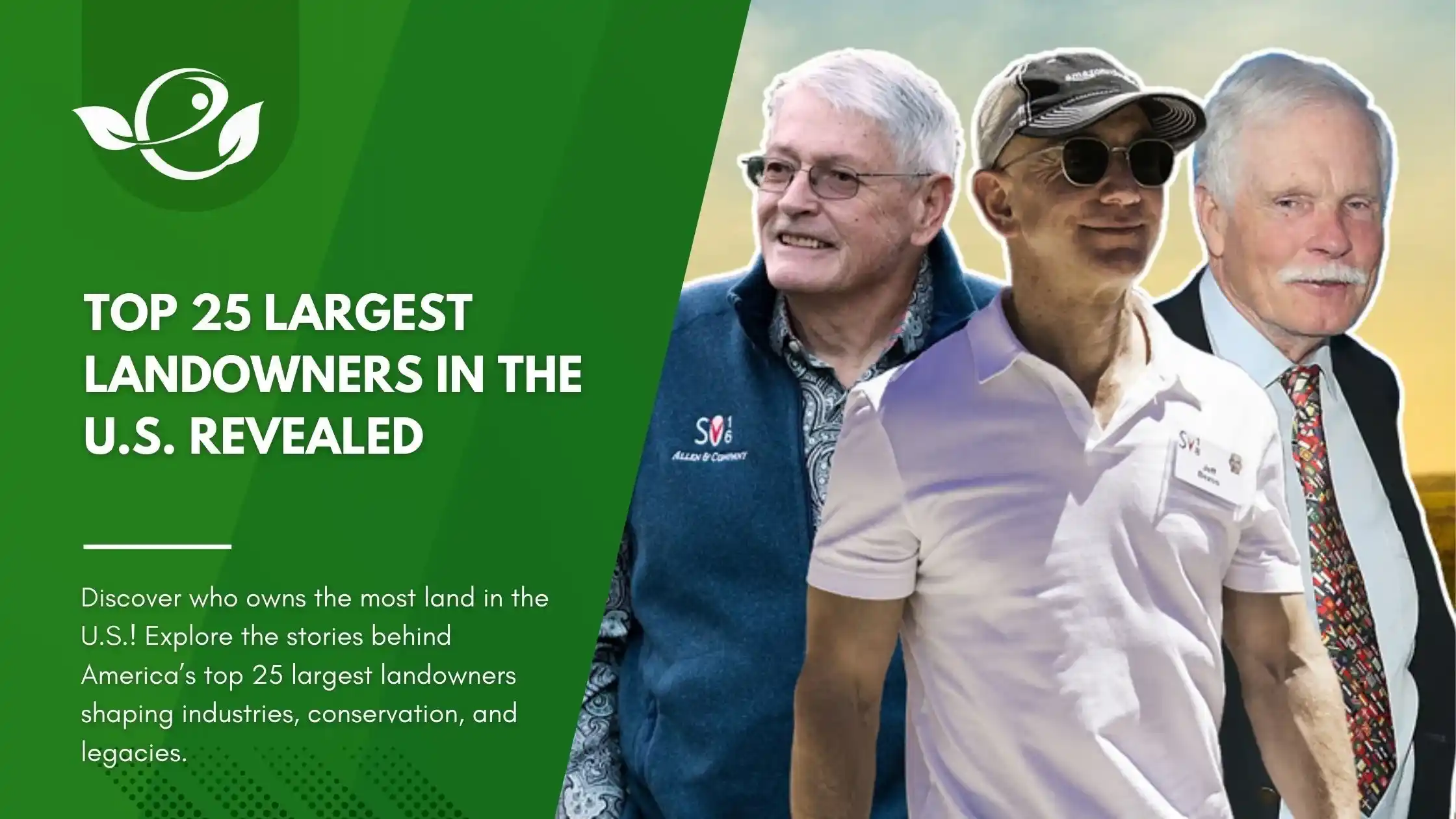Table of Contents
Who owns the most land in the U.S.? It’s a question that sparks curiosity and often unveils surprising truths about wealth, power, and legacy. Land in America isn’t just about space; it’s a valuable asset that defines industries, influences communities, and shapes the country’s future. From sprawling ranches in Montana to vast timberlands in Maine, the largest private landowners control millions of acres. These individuals and families aren’t just wealthy—they are stewards of significant natural and economic resources, making decisions that impact conservation, agriculture, and commerce on a national scale.
This article takes a deep dive into the top 25 largest landowners in the U.S., exploring who they are, where their holdings are located, and why they matter. You’ll learn how these vast tracts of land are used, from cattle ranching to environmental preservation, and discover the stories behind some of America’s most iconic properties.
Understanding Landownership in the U.S.
What Defines Landownership?
In the U.S., landownership is a mix of public and private holdings. The federal government owns approximately 27% of the country’s total landmass, primarily concentrated in the western states. In contrast, private landowners control nearly 60% of the land, with their holdings used for everything from agriculture and forestry to recreation and conservation.
Ownership rights are legally protected and include the ability to use, lease, or sell the land. However, these rights come with responsibilities, particularly for large-scale landowners whose actions can impact ecosystems, local communities, and economies.
The Evolution of Landownership
Historically, land ownership in the U.S. was tied to wealth and status. Land grants during westward expansion and acquisitions in the 19th century created many of the foundational estates we see today. In modern times, industrialization and economic diversification have shifted ownership patterns. Families with deep roots in timber, agriculture, or oil have retained vast holdings, while new owners from tech, media, and finance have entered the ranks of the largest landowners.
The Significance of Large Landholdings
Why does landownership matter? Beyond financial investment, large landholdings have significant implications:
- Economic Impact: Landowners contribute to agriculture, timber, tourism, and energy industries, creating jobs and driving local economies.
- Environmental Stewardship: Many landowners dedicate portions of their land to conservation efforts, protecting forests, grasslands, and wildlife.
- Cultural Legacy: Large estates often represent generational wealth and reflect unique histories of family or corporate ownership.
Statistics and Trends
The top private landowners in the U.S. collectively control tens of millions of acres. Notable trends include:
- Geographic Concentration: Large holdings are most common in the western and southern states due to their vast rural areas and favorable conditions for industries like ranching and timber.
- Diverse Industries: Timber, cattle ranching, conservation, and real estate development are key uses of privately-owned land.
Increasing Consolidation: Wealthy individuals and investment groups are acquiring more land, reflecting a growing trend of land as a long-term investment asset.
The Top 25 Largest Landowners in the U.S.
Private land ownership in the U.S. is often associated with wealth and influence. The following ranking highlights individuals, families, and corporations that control the most land in the country. Each has unique stories about how they acquired their holdings and what they use them for.

1. John Malone – 2.2 Million Acres
Known as the “Cable Cowboy,” John Malone is the largest private landowner in the U.S. A media mogul and philanthropist, Malone’s holdings include timberlands in Maine and New Hampshire and expansive ranches in Colorado, New Mexico, and Wyoming. His focus on sustainable forestry and conservation has earned him respect in environmental circles.
2. Emerson Family – 2.1 Million Acres
Rooted in the timber industry, the Emerson family has amassed vast tracts of land primarily in the Pacific Northwest and southern states. Their company, Sierra Pacific Industries, is one of the largest private landowners in California, with a focus on sustainable timber harvesting.
3. Ted Turner – 2.0 Million Acres
The founder of CNN, Ted Turner, uses his landholdings to blend business and conservation. His ranches in Montana, New Mexico, and South Dakota are home to significant bison herds and serve as models for sustainable land management. Turner’s philanthropy extends to preserving ecosystems and supporting wildlife conservation.
4. Reed Family – 1.7 Million Acres
The Reeds own Green Diamond Resource Company, a leading timber company with land in California, Oregon, and Washington. Their holdings highlight the enduring value of sustainable forestry in the Pacific Northwest.
5. Stan Kroenke – 1.6 Million Acres
As a sports team owner and businessman, Stan Kroenke has built an impressive land portfolio, including ranches in Montana and Texas. His ranching operations span cattle production and conservation initiatives.
6. Irving Family – 1.25 Million Acres
The Irving family owns significant timberlands in Maine and New Brunswick, Canada. Their holdings are vital to the forestry and paper industries and reflect a long-standing commitment to sustainable resource management.
7. Peter Buck Family – 1.2 Million Acres
The Subway co-founder invested heavily in timberlands across the U.S., leaving a legacy of vast natural resources.
8. King Ranch Heirs – 911,215 Acres
The King Ranch in Texas is one of the most iconic ranches in the U.S. Founded in 1853, it remains under the stewardship of the King heirs, who have diversified its operations into cattle ranching, hunting, and farming. The ranch is also a leader in sustainable land management practices, ensuring its legacy endures for future generations.
9. Pingree Heirs – 830,000 Acres
The Pingree family’s landholdings are centered in Maine, where their forested acres support a thriving timber industry. For over 150 years, the Pingrees have been committed to sustainable forestry practices, balancing economic productivity with environmental conservation.
10. O’Connor Heirs – 580,000 Acres
With land primarily located in Texas, the O’Connor family’s holdings are rooted in ranching and oil production. Their stewardship has turned their properties into valuable assets for both agriculture and energy development.
11. Stan Kroenke and Ann Walton Kroenke – 520,000 Acres
In addition to his independent holdings, Stan Kroenke and his wife, Ann Walton Kroenke (an heiress to the Walmart fortune), own significant land together. Their sprawling ranches include properties in Montana and Wyoming, making them prominent figures in the Western ranching community.
12. Fasken Family – 500,000 Acres
The Fasken family’s landholdings are centered in Texas, where their properties are used for cattle ranching and energy production. The family’s foresight in balancing traditional ranching with modern industries ensures the longevity of their holdings.
13. Stimson Family – 500,000 Acres
As one of the oldest timber families in the U.S., the Stimsons own large tracts of forestland in the Pacific Northwest. Their commitment to sustainable forestry has made them leaders in the timber industry for over 150 years.
14. Wilks Brothers – 400,000 Acres
The Wilks brothers, Dan and Farris, made their fortune in the fracking industry and reinvested it into land. Their holdings span several states, including Texas, Montana, and Idaho, where they focus on ranching and conservation efforts.
15. Singleton Family – 400,000 Acres
The Singleton family owns extensive ranchlands in New Mexico, where they operate cattle and agricultural enterprises. Their commitment to maintaining the Western ranching tradition is central to their holdings.
16. Collins Family – 311,000 Acres
The Collins family is another key player in the timber industry. Their landholdings, primarily located in California and Oregon, reflect a legacy of responsible forestry and natural resource management.
17. Jeff Bezos – 290,000 Acres
Amazon’s founder, Jeff Bezos, is not just a tech entrepreneur; he is also one of America’s largest landowners. Bezos owns large properties in Texas and New Mexico, including a sprawling ranch that serves as the base for his space exploration company, Blue Origin.
18. Ford Family – 242,000 Acres
The Ford family owns vast timberland holdings in Oregon. Their sustainable practices and investment in forestry have cemented their role as influential land stewards in the Pacific Northwest.
19. W.T. Waggoner Estate – 240,000 Acres
Located in Texas, the W.T. Waggoner Ranch is one of the largest contiguous ranches in the U.S. It was sold in 2016 to Stan Kroenke but remains a symbol of the Lone Star State’s ranching heritage.
20. King Brothers – 215,000 Acres
The King Brothers own extensive ranchland in Montana, where they focus on cattle operations and land conservation. Their properties highlight the enduring appeal of ranching in the American West.
21. Thomas Peterffy – 200,000 Acres
The founder of Interactive Brokers, Thomas Peterffy, has invested heavily in land, primarily in Florida and the Northeast. His holdings reflect a mix of agricultural operations and personal retreat spaces.
22. Brad Kelley – 200,000 Acres
Brad Kelley made his fortune in the tobacco industry and channeled his wealth into acquiring land. His properties, located in Kentucky and Texas, are used for conservation and agriculture.
23. Andre Agassi and Steffi Graf – 190,000 Acres
The tennis legends turned philanthropists own significant landholdings in Idaho and Montana, where they focus on wildlife conservation and sustainable development.
24. Paul Fireman – 175,000 Acres
The former CEO of Reebok, Paul Fireman, owns large properties in Montana and Wyoming. His focus on conservation has transformed his land into thriving ecosystems for native species.
25. Anschutz Family – 175,000 Acres
The Anschutz family’s holdings are centered in Colorado, where they own vast ranchlands and operate energy businesses. Phil Anschutz, a billionaire with interests in real estate and entertainment, uses his landholdings to diversify his portfolio and support conservation initiatives.
Spotlight: Who Owns the Most Land in the U.S.?
John Malone tops the list, owning 2.2 million acres. His holdings represent a combination of strategic investment and a passion for conservation. From forested timberlands to expansive cattle ranches, Malone’s approach exemplifies the diverse motivations behind large-scale landownership.
Patterns Among America’s Largest Landowners
Industry Connections
Many landowners have ties to industries such as:
- Timber: Families like the Reeds and Irvings dominate this sector.
- Ranching: Ted Turner and Stan Kroenke are prime examples.
- Media and Technology: John Malone leveraged his fortune from telecommunications to acquire land.
Geographic Trends
The West and South are hotspots for large landholdings due to their availability of vast, undeveloped tracts. States like Montana, Texas, and New Mexico feature prominently in the portfolios of the top landowners.
Legacy vs. New Ownership
While some families, like the Reeds, have owned land for generations, others, like Peter Buck’s family, represent modern acquisitions. This mix highlights how landownership in the U.S. evolves over time.
Why Do People Own So Much Land?
Motivations Behind Land Ownership
- Financial Investment
Land is a stable asset that often appreciates over time, making it a preferred investment for the wealthy. - Environmental Conservation
Many landowners dedicate portions of their land to conservation, preserving ecosystems and wildlife. - Agriculture and Ranching
Land is essential for farming and ranching operations, which provide food and resources to the nation. - Legacy and Status
Owning large tracts of land is a symbol of prestige and a way to create generational wealth.
The Power and Responsibility of Large Landowners
With great landholdings come great responsibilities. Landowners influence local economies, environmental policies, and land use practices. For example, Ted Turner’s ranches have become models for sustainable land management.
Conclusion
The largest landowners in the U.S. shape industries, influence policies, and preserve ecosystems. From John Malone’s timberlands to Ted Turner’s conservation efforts, their stories reflect the diverse motivations and impacts of landownership.
Which of these landowners surprised you the most? Share your thoughts in the comments below!
FAQs About Landownership in the U.S.
Who Owns the Most Land in the U.S.?
John Malone, with 2.2 million acres, is the largest private landowner in the country.
How Is Landownership Measured?
Landownership is typically measured by acreage, verified through public records and tax filings.
Is Owning Large Amounts of Land Profitable?
Yes, land can be highly profitable when used for industries like timber, ranching, or real estate. However, it also requires significant investment and management.
Can Ordinary People Buy Large Amounts of Land?
While challenging, individuals can start with smaller plots and expand over time through strategic investments.








